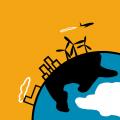
This Guide for Educators was developed by the MIT Environmental Solutions Initiative as an extension of our TILclimate (Today I Learned: Climate) podcast, to make it easier for you to teach climate change, earth science, and energy topics in the classroom. It is an extension of the TILclimate episode "TIL about carbon capture."
Browse all TILclimate guides for educators.
Description
Carbon capture and storage (CCS) and carbon capture and utilization (CCU) are growing technologies. In a hands-on chemistry lab, students can produce a key ingredient in low-carbon concrete. Through reading, discussion, and data exploration, students investigate the future and potential for CCS as one tool in our toolbox to slow climate change.
SWBAT:
-
Explain the basic concept of carbon capture and storage.
-
Explain why it is important to reduce carbon emissions.
-
Understand that no one technology will solve all the problems of climate change.
Skills:
- Handling of simple chemicals
- Reading and communication
- Map-reading
Standards:
-
HS-ETS1-3 Evaluate a solution to a complex real-world problem.
-
HS-PS1-2 Construct and revise an explanation for the outcome of a simple chemical reaction.
-
HS-PS2-6 Communicate scientific and technical information about why the molecular-level structure is important in the functioning of designed materials.
-
CCSS.ELA-LITERACY.RI Reading Informational Text
-
CCSS.ELA-LITERACY.RST Science & Technical Subjects
Disciplinary core ideas:
-
ESS3.A Natural Resources
-
ESS3.C Human Impacts on Earth Systems
-
ESS3.D Global Climate Change
-
ETS1.A Defining and Delimiting an Engineering Problem
What is included in this Educator Guide
- How to use TILclimate Educator Guides (Download)
- Full Educator Guide (Download)
- Includes both Teacher and Student pages
- Includes both Teacher and Student pages
- Teacher pages (Download)
- Includes materials, discussion questions, background resources, and adaptation suggestions for science, social science, and ELA teachers
- Includes materials, discussion questions, background resources, and adaptation suggestions for science, social science, and ELA teachers
- Student pages (Download)
-
Reading: Concrete & Biomimicry
-
Hands-on Lab: Concrete Without Quarries from the Biomimicry Institute
-
Reading & Discussion: Carbon Capture
-
Investigation: Carbon Capture and Storage Facilities
-
Listen to the episode


